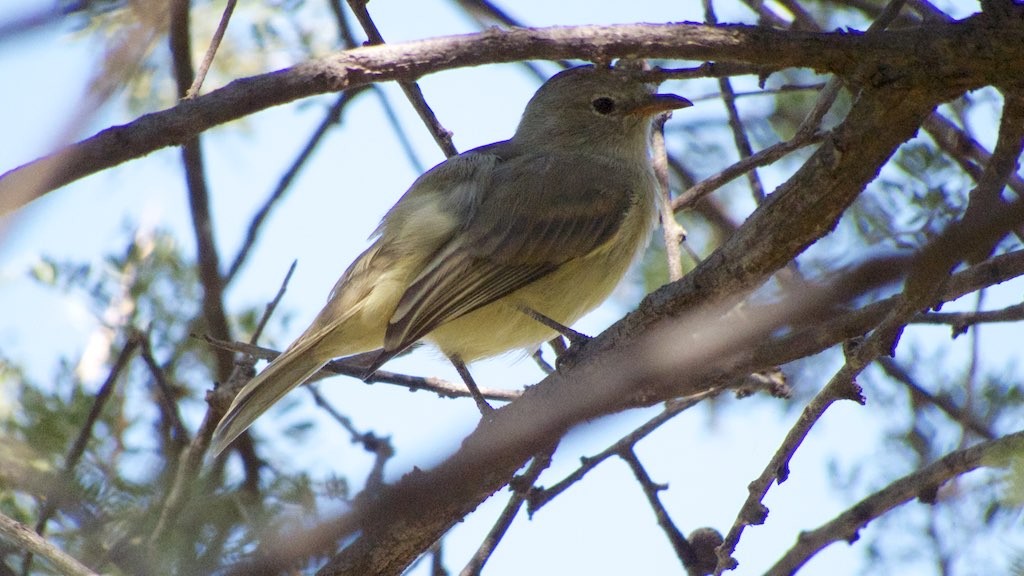Northern Beardless-tyrannulet
A species of Beardless-tyrannulets Scientific name : Camptostoma imberbe Genus : Beardless-tyrannulets
Northern Beardless-tyrannulet, A species of Beardless-tyrannulets
Botanical name: Camptostoma imberbe
Genus: Beardless-tyrannulets
Content
Description General Info
Description
The northern beardless tyrannulet (Camptostoma imberbe) is a small passerine bird in the tyrant flycatcher family. It breeds from southeasternmost Arizona and Texas of the United States through Mexico and Central America to northwestern Costa Rica. This species is found in light forests, cultivation and gardens with trees. The domed nest is made of plant fibre or leaves with a side entrance. The nest is placed by a tree fork. The typical clutch is two white eggs, which are marked with rufous and lilac mostly at the larger end. Incubation by the female is 14–15 days to hatching, with another 17 days to fledging. The northern beardless tyrannulet is 10.2 cm (4.0 in) long, and weighs 7.5 g (0.26 oz). The head is dark brown with an erectile crest and pale supercilium. The upperparts are grey-green becoming paler on the rump. The wings are brown with yellow feather-edging and two whitish wing bars. The tail is brown, the throat grey, the breast yellowish, and the abdomen yellow. The bill is pinkish. Sexes are similar, and this species always appears not as bright, especially with regard to the wing bars, as the closely related southern beardless tyrannulet, C. obsoletum, with which it was once considered conspecific. However, the two forms overlap without interbreeding in Costa Rica. Northern beardless tyrannulets are active birds, feeding in a vireo or warbler-like fashion on insects, spiders and berries. The call is a loud whistled Fleeeeeerrr, sometimes broken up as a fleeer-it, or a flee-flee-flee-flee. In courtship, or when alarmed, the crests are raised, the tail flicked, and an excited call is made. 
Size
11 cm (4.5 in)
Life Expectancy
6 years
Nest Placement
Tree
Clutch Size
1 - 3 eggs
Incubation Period
1 - 2 broods
Number of Broods
14 - 16 days
Nestling Period
12 days
Feeding Habits
Northern Beardless-tyrannulet primarily consume insects and spiders by hopping along branches and plucking them from foliage. They occasionally catch insects mid-flight. Their diet is supplemented with seeds and small berries.
Habitat
The northern Beardless-tyrannulet occupies woodland habitats often near water, spanning low woods to lower canyons in arid to semi-arid climates. Typical environments include mesquite groves, stream-side thickets, and thorn forests with altitudinal ranges from 2,000 to 4,500 feet. These birds thrive in regions with woodland-adjacent streams and varied forests with vegetation such as cedar elm and sugar hackberry.
Nest Behavior
Females build the nest and incubate. Timing for nest building and egg-laying varies regionally, with parental care adapted to the best use of available resources and conditions to protect and raise their young successfully.
Nest Characteristics
Northern Beardless-tyrannulet's nest is a camouflaged, globular or domed structure with an entrance at the top or side, woven from grasses, leaves, bark, and plant fibers. Placement varies, with heights from 6–40 feet and sometimes in caterpillar webbing in trees or among epiphytes in cedar elms.
Dite type
Insectivorous
General Info
Feeding Habits
Bird food type
Sounds
Call
Recording location: Mexico
Song
Recording location: Mexico
Song
Recording location: Mexico
Behavior
Northern Beardless-tyrannulet exhibit behavior more akin to vireos than their flycatcher counterparts, often hopping across branches and gleaning insects from foliage rather than catching them mid-flight. A characteristic tail-flicking motion, both when perched and active, distinguishes their movements. These solitary birds showcase raised head feathers when upset. While typically lone creatures, they pair up during the breeding season, otherwise maintaining a preference for solitude in their daily routines.
Species Status
Not globally threatened.
Scientific Classification
Phylum
Chordates Class
Birds Order
Perching birds Family
Tyrant flycatchers Genus
Beardless-tyrannulets Species
Northern Beardless-tyrannulet 